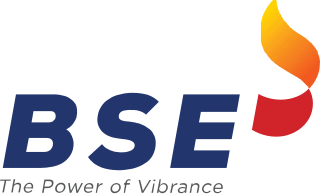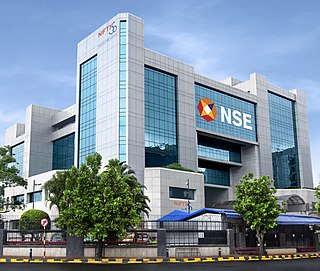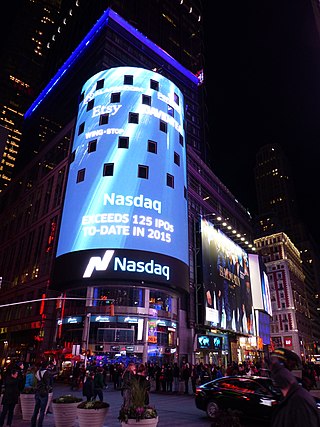Related Research Articles

A stock market, equity market, or share market is the aggregation of buyers and sellers of stocks, which represent ownership claims on businesses; these may include securities listed on a public stock exchange as well as stock that is only traded privately, such as shares of private companies that are sold to investors through equity crowdfunding platforms. Investments are usually made with an investment strategy in mind.

Home automation or domotics is building automation for a home. A home automation system will monitor and/or control home attributes such as lighting, climate, entertainment systems, and appliances. It may also include home security such as access control and alarm systems.

The Securities and Exchange Board of India (SEBI) is the regulatory body for securities and commodity market in India under the administrative domain of Ministry of Finance within the Government of India. It was established on 12 April 1988 as an executive body and was given statutory powers on 30 January 1992 through the SEBI Act, 1992.

BSE Limited, also known as the Bombay Stock Exchange (BSE), is an Indian stock exchange which is located on Dalal Street, known as the Wall Street of Mumbai, in turn described as the New York of India. Established in 1875 by cotton merchant Premchand Roychand, it is the oldest stock exchange in Asia, and also the tenth oldest in the world. The BSE is the world's 7th largest stock exchange with a market capitalization exceeding US$5 trillion as of May 2024.

National Stock Exchange of India Limited (NSE) is one of the leading stock exchanges in India, based in Mumbai. NSE is under the ownership of various financial institutions such as banks and insurance companies. It is the world's largest derivatives exchange by number of contracts traded and the third largest in cash equities by number of trades for the calendar year 2022. It is the 8th largest stock exchange in the world by total market capitalization, as of May 2024. NSE's flagship index, the NIFTY 50, is a 50 stock index that is used extensively by investors in India and around the world as a barometer of the Indian capital market. The NIFTY 50 index was launched in 1996 by NSE.

Information and communications technology (ICT) is an extensional term for information technology (IT) that stresses the role of unified communications and the integration of telecommunications and computers, as well as necessary enterprise software, middleware, storage and audiovisual, that enable users to access, store, transmit, understand and manipulate information.

Nasdaq, Inc. is an American multinational financial services corporation that owns and operates three stock exchanges in the United States: the namesake Nasdaq stock exchange, the Philadelphia Stock Exchange, and the Boston Stock Exchange, and seven European stock exchanges: Nasdaq Copenhagen, Nasdaq Helsinki, Nasdaq Iceland, Nasdaq Riga, Nasdaq Stockholm, Nasdaq Tallinn, and Nasdaq Vilnius. It is headquartered in New York City, and its president and chief executive officer is Adena Friedman.
Renaissance Learning, Inc. is a software as a service and learning analytics company that makes cloud-based, Pre-K–12 educational software and adaptive assessments. Renaissance employs about 1,000 employees in nine U.S. cities and subsidiaries in Canada, the United Kingdom, Korea, and Australia. Renaissance's solutions are used in one-third of U.S. schools and more than 90 countries around the world.
Algorithmic trading is a method of executing orders using automated pre-programmed trading instructions accounting for variables such as time, price, and volume. This type of trading attempts to leverage the speed and computational resources of computers relative to human traders. In the twenty-first century, algorithmic trading has been gaining traction with both retail and institutional traders. A study in 2019 showed that around 92% of trading in the Forex market was performed by trading algorithms rather than humans.
The following outline is provided as an overview of and topical guide to finance:
Market microstructure is a branch of finance concerned with the details of how exchange occurs in markets. While the theory of market microstructure applies to the exchange of real or financial assets, more evidence is available on the microstructure of financial markets due to the availability of transactions data from them. The major thrust of market microstructure research examines the ways in which the working processes of a market affect determinants of transaction costs, prices, quotes, volume, and trading behavior. In the twenty-first century, innovations have allowed an expansion into the study of the impact of market microstructure on the incidence of market abuse, such as insider trading, market manipulation and broker-client conflict.
An automated trading system (ATS), a subset of algorithmic trading, uses a computer program to create buy and sell orders and automatically submits the orders to a market center or exchange. The computer program will automatically generate orders based on predefined set of rules using a trading strategy which is based on technical analysis, advanced statistical and mathematical computations or input from other electronic sources.

ILOG S.A. was an international software company purchased and incorporated into IBM announced in January, 2009. It created enterprise software products for supply chain, business rule management, visualization and optimization. The main product line for Business Rules Management Systems (BRMS) has been rebranded as IBM Operational Decision Management. Many of the related components retain the ILOG brand as a part of their name.

In finance, an electronic trading platform also known as an online trading platform, is a computer software program that can be used to place orders for financial products over a network with a financial intermediary. Various financial products can be traded by the trading platform, over a communication network with a financial intermediary or directly between the participants or members of the trading platform. This includes products such as stocks, bonds, currencies, commodities, derivatives and others, with a financial intermediary such as brokers, market makers, Investment banks or stock exchanges. Such platforms allow electronic trading to be carried out by users from any location and are in contrast to traditional floor trading using open outcry and telephone-based trading. Sometimes the term trading platform is also used in reference to the trading software alone.
High-frequency trading (HFT) is a type of algorithmic trading in finance characterized by high speeds, high turnover rates, and high order-to-trade ratios that leverages high-frequency financial data and electronic trading tools. While there is no single definition of HFT, among its key attributes are highly sophisticated algorithms, co-location, and very short-term investment horizons in trading securities. HFT uses proprietary trading strategies carried out by computers to move in and out of positions in seconds or fractions of a second.
David Alan Easley is an American economist. Easley is the Henry Scarborough Professor of Social Science and is a professor of information science at Cornell University.
SIRCA is a provider of online services to support finance and other data-intensive research at universities, Government and financial market participants world-wide.
Craig Woodworth Holden was the finance department chair and Gregg T. and Judith A. Summerville Chair of Finance at the Kelley School of Business at Indiana University. His research focused on market microstructure. He was secretary-treasurer of the Society for Financial Studies. He was an associate editor of the Journal of Financial Markets. His M.B.A. and Ph.D. were from the Anderson School of Management at UCLA. He received the Fama-DFA Prize for the second best paper in capital markets published in the Journal of Financial Economics in 2009, the Spangler-IQAM Award for the best investments paper published in the Review of Finance in 2017-2018, and the Philip Brown Prize for the best paper published in 2017 using SIRCA data. His research has been cited more than 4,300 times. He has written two books on financial modeling in Excel: Excel Modeling in Investments and Excel Modeling in Corporate Finance. He has chaired 22 dissertations, been a member or chair of 62 dissertations, and serves on the program committees of the Western Finance Association and European Finance Association.
In finance, quote stuffing refers to a form of market manipulation employed by high-frequency traders (HFT) that involves quickly entering and withdrawing a large number of orders in an attempt to flood the market. This can create confusion in the market and trading opportunities for high-speed algorithmic traders. The term is relatively new to the financial market lexicon and was coined by Nanex in studies on HFT behavior during the 2010 Flash Crash.
Smart cities seek to implement information and communication technologies (ICT) to improve the efficiency and sustainability of urban spaces while reducing costs and resource consumption. In the context of surveillance, smart cities monitor citizens through strategically placed sensors around the urban landscape, which collect data regarding many different factors of urban living. From these sensors, data is transmitted, aggregated, and analyzed by governments and other local authorities to extrapolate information about the challenges the city faces in sectors such as crime prevention, traffic management, energy use and waste reduction. This serves to facilitate better urban planning and allows governments to tailor their services to the local population.
References
- ↑ Pacific-Basin Finance Journal Volume 9, Issue 3, June 2001, Pages 265-280 and “Most Prolific Authors in the Finance Literature: 1959-2008”, Jean L. Heck and Philip L. Cooley, Working paper, 2009
- ↑ Harris, Frederick H. deB; Aitken, Michael J.; Ji, Shan (21 April 2014). A Worldwide Examination of Exchange Market Quality: Greater Integrity Increases Market Efficiency. SSRN 1890928.
- ↑ Siow, Audris S.; Aitken, Michael J. (February 2004). "Ranking World Equity Markets on the Basis of Market Efficiency and Integrity". In Herbie Skeete (ed.). THE HP HANDBOOK OF WORLD STOCK, DERIVATIVE & COMMODITY EXCHANGES 2003. Mondo Visione Ltd. pp. xlix–lv. SSRN 490462.
- ↑ High Frequency Trading and End of Day manipulation
- ↑ "High frequency trading–assessing the impact on market efficiency and integrity" (PDF). gov.uk.
- ↑ "In profile: Mike Aitken, financial markets guardian".
- ↑ "Waters Rankings 2014: Best Market Surveillance Provider — Nasdaq OMX". waterstechnology.com. August 2014.
- ↑ "B/HERT - Business/Higher Education Round Table". Business/Higher Education Round Table.
- ↑ "TABB Accounts".
- ↑ "New aid for regulators in measuring reform_impact". thetradenews.com. Archived from the original on 2014-08-02. Retrieved 2014-10-07.
- ↑ Market Quality Dashboard - Exclusive First Look!. 19 December 2013 – via YouTube.
- ↑ "CMCEC". Archived from the original on 2014-12-16. Retrieved 2014-10-07.
- ↑ Nasdaq. "Nasdaq Tech: Surveillance Solutions".
- ↑ "Lorica Health - A CMCRC Company". Archived from the original on 2014-10-29. Retrieved 2014-10-07.
- ↑ "Consulting - Capital Markets Technologies".
- ↑ "Capital Markets Cooperative Research Centre awarded $32M to continue critical research in finance and health | CMCRC". Archived from the original on 2014-10-31. Retrieved 2014-10-07.
- ↑ "CMC Insurance Solutions | About us". Archived from the original on 2014-07-20. Retrieved 2014-10-07.
- ↑ "Michael Aitken,Capital Markets Consulting,Expert Witnesses,Finance". Archived from the original on 2014-10-07. Retrieved 2014-10-07.
- 1 2 "Nod for keeping markets clean". The Australian.
- ↑ "Case Study - Capital Markets CRC".
- ↑ Aitken, Michael (1980). Towards establishing a research tradition in accounting (Masters thesis). Massey Research Online, Massey University. hdl:10179/11290.